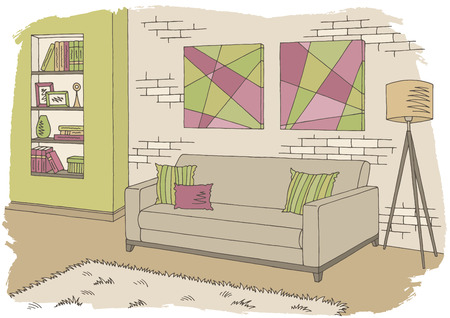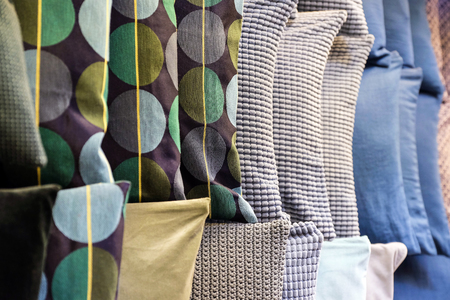Understanding the UK Climate’s Influence on Fabric Choice
The British weather is famously unpredictable, with chilly winters, damp autumns, occasional heatwaves in summer, and frequent rain showers scattered throughout the year. This ever-changing climate has a significant impact on fabric selection for throws, cushions, and rugs in UK homes. When choosing textiles, it is essential to consider both comfort and practicality. For example, during colder months, heavier fabrics such as wool or thick cotton blends provide much-needed warmth and insulation. In contrast, lighter materials like linen or breathable cotton are more suitable for the warmer spells of spring and summer, ensuring spaces remain airy and comfortable. Additionally, the high humidity and risk of dampness mean that moisture-resistant and easy-to-clean fabrics are preferable to maintain longevity and freshness. By understanding how the UK climate affects daily living conditions, homeowners can make informed decisions when selecting materials that enhance both the functionality and style of their interiors all year round.
2. Popular Fabric Options: Pros, Cons, and Local Preferences
When selecting fabrics for throws, cushions, and rugs in UK homes, its essential to consider not only comfort and durability but also the distinct climate and cultural preferences. British households commonly turn to four main fabric categories: wool, cotton, linen, and synthetic blends. Each of these materials brings unique advantages and potential drawbacks, as outlined below.
| Fabric | Pros | Cons | UK Popularity & Typical Uses |
|---|---|---|---|
| Wool | Excellent insulation; naturally flame-retardant; highly durable; resists soiling; luxurious texture | Can be costly; may feel itchy for some; requires special cleaning; prone to moth damage if untreated | Very popular for throws and rugs due to warmth—ideal for draughty Victorian terraces or country cottages; valued in both traditional and modern interiors |
| Cotton | Soft feel; breathable; easy care; widely available; hypoallergenic properties | Can fade or shrink after repeated washing; less insulating than wool; wrinkles easily | Favoured for cushions and summer throws in family homes; commonly found in coastal or contemporary British interiors seeking a fresh look |
| Linen | Natural look; strong fibres; cool in summer; eco-friendly | Wrinkles easily; can feel rough initially; needs gentle laundering | Increasingly popular for cushions in minimalist or Scandi-inspired spaces across the UK; often chosen for its understated elegance |
| Synthetic Blends (e.g., Polyester, Acrylic) | Affordable; stain-resistant; colourfast; easy maintenance | Less breathable than natural fibres; may pill over time; environmental concerns with microplastics | A go-to option for busy households, student accommodation, or rental properties where practicality is key—commonly used in machine-washable throws and budget-friendly rugs |
Local Preferences and Considerations
The British Approach to Comfort and Practicality
The unpredictable UK weather means warmth is a priority—wool remains a classic choice for its ability to trap heat during chilly evenings. Cotton and linen are embraced during the milder months or in well-insulated new builds. Meanwhile, synthetic blends cater to those seeking fuss-free upkeep, particularly families with young children or pets.
Cultural Touchpoints
The resurgence of heritage styles has seen tartan wool throws and Harris Tweed cushions become sought-after items, especially in period homes. In contrast, urban flats favour sleek cottons and practical synthetics that align with fast-paced city living.

3. Durability and Maintenance for Everyday British Living
When selecting fabrics for throws, cushions, and rugs in UK homes, durability and ease of maintenance are key considerations—especially for busy households with children, pets, or frequent guests. The unpredictable British weather, with its frequent rain and varying humidity levels, means that textiles must withstand not only daily use but also the challenges posed by damp conditions. Opting for robust materials such as tightly woven cotton blends, wool mixes, or performance fabrics can help ensure your soft furnishings remain looking fresh over time. These options tend to resist pilling and wear, making them well-suited to high-traffic areas like living rooms and family spaces.
For those with pets or young children, it’s wise to choose fabrics that are both stain-resistant and easy to clean. Look out for machine-washable labels or removable covers that can be popped into the wash after muddy walks or accidental spills—a lifesaver during wet British winters. Additionally, synthetic fibres such as polyester or acrylic blends often offer better moisture resistance than pure natural fibres, which can help guard against mildew in more humid regions of the UK. By prioritising hard-wearing, low-maintenance fabrics tailored to your household’s needs, you can keep your home comfortable and inviting without constant upkeep.
4. Selecting Fabrics for Style and Comfort
When choosing fabrics for throws, cushions, and rugs in UK homes, balancing style with comfort is essential. The texture, colour, and design of your chosen materials can dramatically influence both the visual appeal and the inviting atmosphere of a room. British interiors often celebrate a harmonious blend of classic elegance and contemporary flair, so selecting fabrics that reflect this heritage while embracing modern sensibilities can truly elevate your living space.
Texture: Creating Depth and Warmth
The tactile quality of fabric contributes significantly to the cosy feel of a room. Traditional British homes may feature rich textures like wool, velvet, or chenille for warmth and depth, while more modern spaces might favour sleek cottons or blended weaves for a lighter touch. Consider layering different textures—such as pairing a chunky knit throw with smooth linen cushions—to create visual interest and a sense of comfort year-round.
| Fabric Type | Texture | Best For |
|---|---|---|
| Wool | Soft, warm, slightly coarse | Throws, winter cushions |
| Cotton | Smooth, breathable | Everyday use, summer throws |
| Velvet | Lush, dense pile | Accent cushions for luxury effect |
| Linen Blend | Crisp yet softens with use | Casual, relaxed settings |
| Synthetic Fibres | Varied (from smooth to shaggy) | Rugs requiring durability and easy care |
Colour: Setting the Mood
The colour palette you select sets the overall tone of your space. Classic British interiors often lean towards muted hues such as sage green, slate grey, or navy blue, complemented by neutral creams and taupes. Contemporary trends may introduce bolder accent colours or playful pastels for a fresh twist. When coordinating throws, cushions, and rugs, choose shades that either harmonise with your existing décor or offer contrast for a statement look.
Popular Colour Pairings in UK Homes:
- Navy & Mustard – Sophisticated yet lively contrast ideal for modern sitting rooms.
- Sage Green & Cream – Timeless combination suited to country cottages or period properties.
- Charcoal Grey & Blush Pink – Soft contemporary palette perfect for urban flats.
- Deep Red & Taupe – Warmth and tradition balanced with understated charm.
Design: Bridging Classic and Contemporary Trends
The design or pattern on your fabrics can nod to traditional British motifs—think tartans, florals, or herringbone weaves—or adopt modern geometric prints for a current feel. To maintain cohesion in your interiors:
- Mix subtle patterns with solids to avoid overwhelming the space.
- Limit bold prints to one feature piece (such as a statement rug) while keeping other elements more restrained.
- Select designs that echo architectural details or period features in older UK homes.
In Summary:
The right combination of fabric texture, colour, and design will not only enhance the style of your UK home but also ensure lasting comfort. Whether you’re inspired by timeless British charm or looking to make a contemporary statement, thoughtful fabric choices are key to creating an inviting space that reflects your personal taste.
5. Sustainability and Ethical Choices for UK Consumers
With environmental concerns taking centre stage in the UK, more homeowners are prioritising sustainability when selecting fabrics for throws, cushions, and rugs. Eco-friendly materials such as organic cotton, recycled polyester, hemp, and ethically sourced wool are becoming popular choices for those seeking both comfort and conscience in their interiors.
Eco-Friendly Materials in Home Textiles
Many UK consumers are opting for textiles made from renewable resources or recycled content. Organic cotton, grown without harmful pesticides, is gentle on the environment and perfect for soft furnishings. Recycled polyester, often crafted from post-consumer plastic bottles, offers a durable and low-impact alternative to virgin fibres. Hemp and linen, requiring minimal water and pesticides during cultivation, are also increasingly favoured for their durability and natural look.
Responsibly Sourced Wool and Animal Products
When choosing woollen throws or sheepskin rugs, it is crucial to consider the welfare of animals and the transparency of supply chains. The Responsible Wool Standard (RWS) certification ensures that wool comes from farms with high standards of animal welfare and sustainable land management practices. British brands like The Wool Company and Bronte by Moon are recognised for their commitment to ethical sourcing and traditional craftsmanship.
UK Certifications and Trusted Brands
To ensure your home textiles meet ethical standards, look out for certifications such as OEKO-TEX® Standard 100, which verifies that fabrics are free from harmful substances. The Global Organic Textile Standard (GOTS) is another leading certification guaranteeing organic status throughout production. For sustainable UK brands, consider John Lewis & Partners’ eco ranges or Weaver Green’s stylish recycled plastic bottle rugs—both are dedicated to responsible sourcing and greener manufacturing processes.
By making informed choices about the fabrics in your home, you not only support a healthier environment but also contribute to fairer working conditions across the textile industry. Embracing sustainable options ensures your home remains comfortable, stylish, and aligned with modern British values.
6. Practical Tips: Measuring, Purchasing, and Caring for Your Fabrics
Getting the Right Fit: Measuring for Throws, Cushions, and Rugs
Before purchasing any new throws, cushions, or rugs for your UK home, it’s essential to measure your spaces accurately. For cushions, check the size of your sofa or chairs—standard cushion covers in the UK are often 45x45cm or 50x50cm, but bespoke sizes can add a tailored touch. Throws should be large enough to drape comfortably over furniture without dragging on the floor—measure the width and length of your sofa or bed and allow extra for a generous overhang. When selecting rugs, consider both the size of the room and how much of the floor you want to cover; a rug should ideally sit under at least the front legs of your furniture to anchor the space.
Where to Shop: Local Gems and Trusted Online Retailers
The UK is home to both high street favourites and independent retailers specialising in home textiles. If you prefer shopping in person, John Lewis & Partners, Dunelm, and Marks & Spencer offer a broad range of quality fabrics and ready-made items. For something unique, local markets or small shops such as Liberty London or Heal’s provide distinctive designs. Online, consider Made.com for contemporary styles, Graham & Green for eclectic choices, or Not on the High Street for handmade options. Don’t overlook British brands like Designers Guild or Sanderson for premium fabric by the metre if you’re planning custom pieces.
Maintaining Longevity: Care and Cleaning Advice
To keep your throws, cushions, and rugs looking their best for years to come, follow care instructions closely. Most cotton and synthetic blends can be machine washed on a gentle cycle—always use mild detergent and avoid high heat. Wool items may require hand washing or dry cleaning; spot clean spills promptly with cool water and a soft cloth. For velvet or silk fabrics, professional cleaning is recommended to preserve texture and colour. Rugs benefit from regular vacuuming; rotate them occasionally to ensure even wear. Address stains quickly using appropriate cleaners—test any products on an inconspicuous area first. Lastly, air out your textiles periodically by hanging them outside on a dry day (a classic British airing cupboard works well too) to keep everything fresh.
Handy Hints for Everyday Upkeep
Invest in removable cushion covers wherever possible—they’re much easier to launder than whole cushions. Use anti-slip mats under rugs to prevent movement and reduce wear. Store throws neatly folded when not in use to avoid creasing and dust build-up. By taking these simple steps, you’ll extend the life of your soft furnishings while maintaining a cosy and inviting atmosphere throughout your home.


